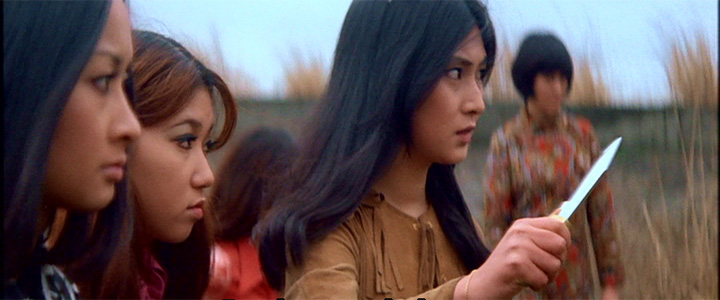★★½
“Not very violent, and certainly not pink.”
 When Rika (Oshida) gets out of reform school, she goes to visit her friend Midori (Katayama), and gets a job working in the garage belonging to Midori’s father Muraki (Ban), even though Midori is estranged from him – except when she needs money to pay off her boyfriend’s gambling debts to the local Yakuza under Boss Ohya (Nobuo Kaneko). Another friend of Rika’s is working in an “art studio”, doing nude modelling to support her sick husband, and still others are hostesses at the Ginza Girls cabaret, a dance-hall which Ohya’s gang are also extorting for protection money. After Muraki has to take a loan using the garage as collateral to pay Ohya, Rika tries to offer herself as an alternative to the boss. This goes about as well as you’d expect, though there’s a genuinely cool twist in which we find someone isn’t quite who we seem. There’s a tragic fatality, which sets the scene for all the girls to get together and take on Ohya’s gang.
When Rika (Oshida) gets out of reform school, she goes to visit her friend Midori (Katayama), and gets a job working in the garage belonging to Midori’s father Muraki (Ban), even though Midori is estranged from him – except when she needs money to pay off her boyfriend’s gambling debts to the local Yakuza under Boss Ohya (Nobuo Kaneko). Another friend of Rika’s is working in an “art studio”, doing nude modelling to support her sick husband, and still others are hostesses at the Ginza Girls cabaret, a dance-hall which Ohya’s gang are also extorting for protection money. After Muraki has to take a loan using the garage as collateral to pay Ohya, Rika tries to offer herself as an alternative to the boss. This goes about as well as you’d expect, though there’s a genuinely cool twist in which we find someone isn’t quite who we seem. There’s a tragic fatality, which sets the scene for all the girls to get together and take on Ohya’s gang.
As you can tell, there’s no shortage of plot going on here. However, the overall result is more like an overwrought Japanese soap-opera, with a lack of much delinquence, or indeed, real action of any kind from the girls, up until the last ten minutes. Indeed, there’s very little exploitation present at all, with a surprising lack of nudity as well, though personally, this is less a concern. Reading various reviews elsewhere, there is a broad spectrum of opinion as to whether this makes it the best or the worst in the series. I tend to be somewhere in the middle: while I can appreciate the dramatic elements, and the two lead actresses are good in their roles, it’s not what I expected at all, being too worthy, and completely lacking any sense of excess of transgression.
I’m definitely uncertain where the poster image comes from, although that may be because I had to look at it twice, since the first time I thought she was holding a yo-yo. Must have been some kind of residue from Sukeban Deka, I guess.
Dir: Kazuhiko Yamaguchi
Star: Reiko Oshida, Yumiko Katayama, Junzaburo Ban





